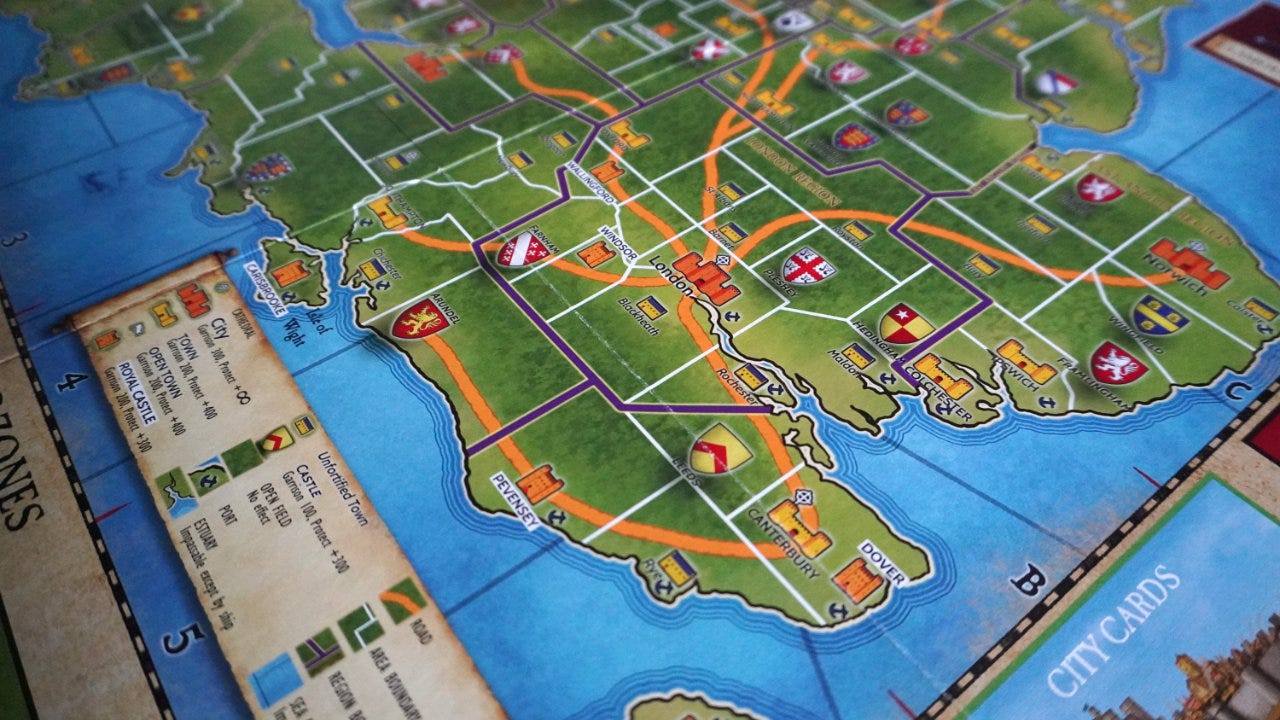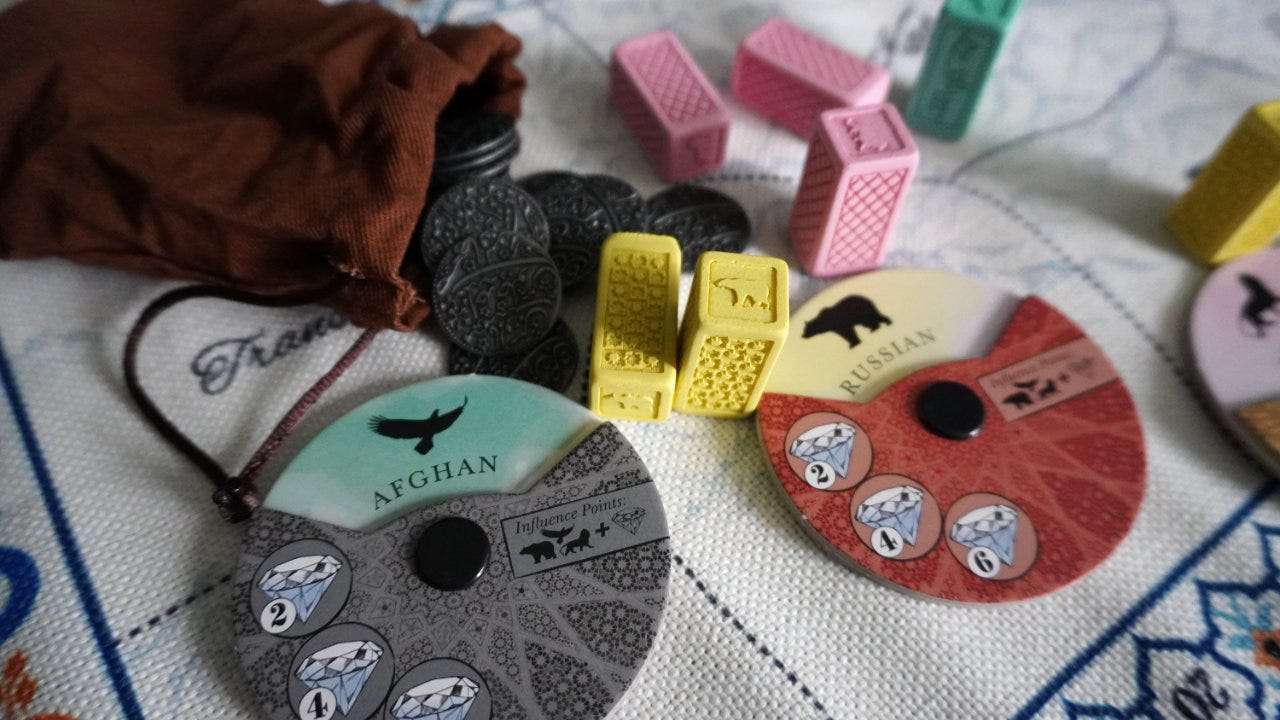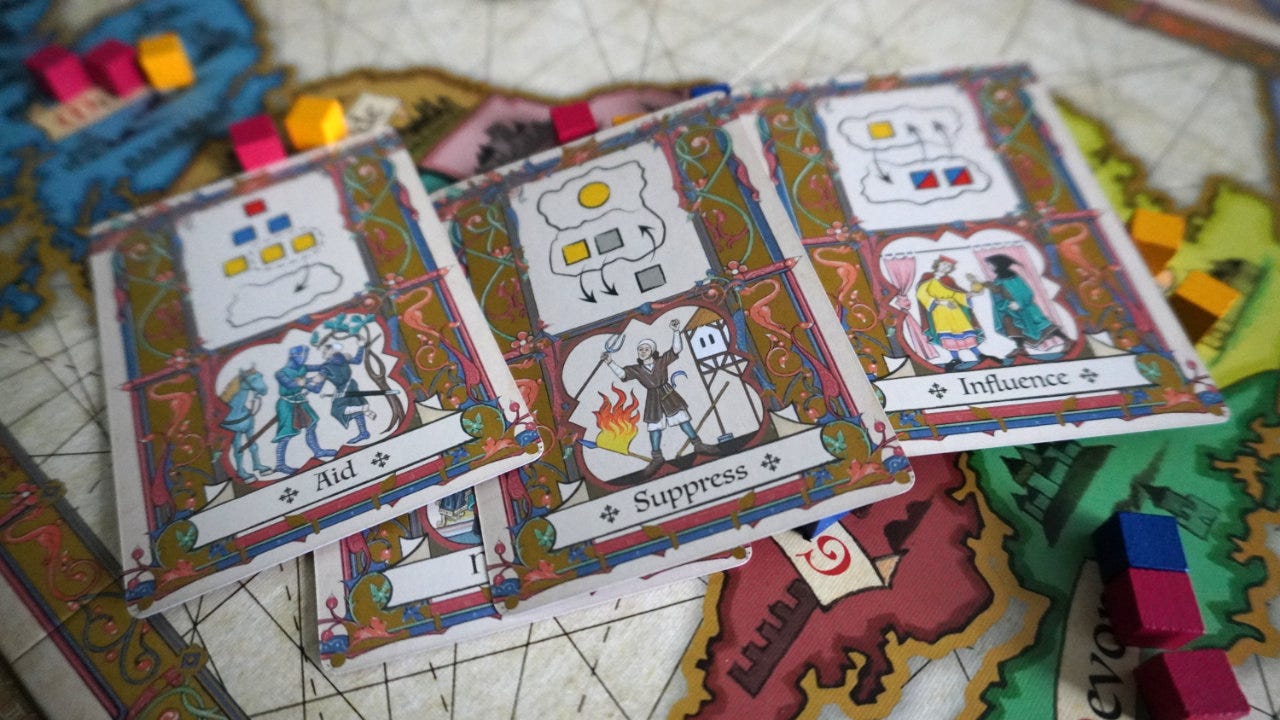Solving the three-player problem
Kingmaking, turtling, and other problems in multiplayer conflict games
Welcome to Skeleton Code Machine, a weekly publication that explores tabletop game mechanisms. Spark your creativity as a game designer or enthusiast, and think differently about how games work. Check out Dungeon Dice and 8 Kinds of Fun to get started!
Last week we looked at Mothership RPG and roll over vs. roll under dice systems. If you missed it, you can read that article and all others in the Skeleton Code Machine Archive.
This week we look at a design problem that I’ve thought about a lot over the years: three-player conflict.
The Three-Player Problem
I’ve been reading Tabletop: Analog Game Design (Costikyan & Davidson, 2011) and was struck by the chapter called “The Three-Player Problem.” Lewis Pulsipher, the chapter’s author, has a long history with both Dungeons & Dragons and historical wargaming. So I was very interested in his opinions!
First, let’s define the three-player problem…
In a three-player conflict game (e.g. a historical wargame) if there are three players, the two players who are behind will generally team up and attack the player in the lead.
This emergent “bash the leader” results in one or more of the following three problems:
The game goes on forever: If there is no fixed end to the game, one player gets ahead and is bashed by the two other players. A new leader emerges, and the process repeats potentially forever.
The player who doesn’t fight will win: One player attacks the leader, causing them both to expend resources and end up weakened and less likely to win. The third player who avoided the conflict, can easily defeat the others and claim victory.
Petty diplomacy: Once a player knows they can’t win the game, they may act as a spoiler. The player who can’t win attacks one of the two players who can win, destroying their chance of victory and causing the other player to win. The attacking player acted as a “kingmaker” by deciding who gets to win.
This three-player problem can show up in any games that have direct conflict (e.g. combat) and especially when battles use up the player’s resources (e.g. units).
It’s why playing three-player BattleTech, Cyberpunk Red: Combat Zone, and Risk can be tricky and problematic.
Specific multiplayer problems
The chapter does a really nice job of outlining the specific gameplay problems that arise from the three-player problem, noting that they can show up at any player count.
Pulsipher’s list outlines a vocabulary to describe when these problems arise in a design and during playtesting:
1. Turtling
Turtling is a gameplay strategy that focuses solely on defense rather than offense, usually showing up in area control games. A player sits in an uncontested area of the map, accumulating resources and never launching an attack. The other players will continue to fight and weaken themselves. Once the opponents have become sufficiently weak, the turtling player can attack and win the game.
This can be a viable strategy in three-player Blood Rage (Lang, 2015) if you are able to draft the cards that allow you to re-pillage the same province repeatedly. It can also happen in Eclipse: Second Dawn for the Galaxy (Tahkokallio, 2020).
Large maps with few players can lead to players using this strategy, because there is more room to “hide” on the map. With more players and/or a smaller map, factions are forced to interact, and it is harder to turtle.
2. Leader bashing
Pulsipher defines leader bashing as “simply the tendency to attack whoever is ahead.” Players will watch to see who is gaining the most victory points, controlling the most area, or otherwise positioned to win. The other players will then team up (explicitly or de facto), and attack them, thereby preventing them from winning.
I’ve seen this happen in Root (Wehrle, 2018) many times, as the Marquise de Cat faction often gains an early lead in the game. The other players all attack the cats, preventing them from winning. Similar leader bashing can take place in other games like Oath: Chronicles of Empire & Exile (Wehrle, 2021) and Pax Pamir: Second Edition (Wehrle, 2019).
3. Sandbagging
The inverse of leader bashing is sandbagging, where a player attempts to obfuscate how well they are doing. Even if a player is amassing resources, points, and power, they might try to disguise this fact.
With hidden information (e.g. hidden victory points or conditions), this is a viable strategy to avoid being the target of leader bashing.
4. Kingmaking
A kingmaking scenario is the more common term for what Pulsipher calls the “petty diplomacy problem.” He’s using a term coined by W. Schmittberger, explained as follows:
“Petty” here is derived from “pettiness,” I believe, implying that the player who thinks he’ll lose often chooses for petty reasons which of the others to take with him to defeat.
As noted above, petty diplomacy or kingmaking means that the winner of the game is not determined by the “best player” but rather arbitrarily by a non-winning player. In fact it can be the player with the most inferior strategy that is the one who decides who wins!
A kingmaking scenario can arise at the end of Kemet: Blood & Sand (Bariot & Montiage, 2021). It’s a tight game where a player only needs 9 victory points to immediately win the game. This can lead to a situation where a player has a choice of attacking one of two other players at the very end of the game. They have no chance of winning themselves, and the other player they attack will also lose. So it is their choice (which is arbitrary) that decides the winner of the game.
Kingmaking is almost always considered undesirable in game design. It can lead to a sense of disappointment, a feeling of lost player agency, and even hard feelings at the table.
Possible solutions
There are some ways to mitigate the above problems, and Pulsipher gives us quite a few options in the chapter. In addition, there are many other articles that attempt to deal with these issues.
Here a few notable design solutions:
Hidden victory information: Concealing the game state as it relates to victory makes it harder to know who the leader might be. This reduces leader bashing and the need for sandbagging. This could be hidden victory points, partially hidden end game victory points, or hidden victory conditions. The end game victory condition cards in Troyes (Dujardin, Georges, et al, 2010) are a good example.
Low player interaction: Euro-style board games often have a “multiplayer solitaire” feeling, where it is extremely hard to directly impact other players. Players can adjust the game state, but are unable to directly attack a specific opponent. This too reduces leader bashing.
Sudden, forecasted, and prevented victory: Pulsipher notes that if it is obvious that a player is going to win, other players will attack them. If this doesn’t knock the target player out of the game, it can be a design strength rather than a flaw. The constant, shifting leader position can be a goal of the design.
Equilibrium and inertia: The game state can be changed, but never by any large increment. With sufficient “equilibrium” any single attack or action doesn’t overly impact the game state. This is similar to the low interaction solution above.
Player elimination: Although it was noted as an outdated game mechanism, eliminating players who have no chance of winning will prevent them from acting as kingmakers. In poor implementation, this can mean a player is sitting out of a game and not having fun. A particularly innovative solution to this is “the merge” in Ankh: Gods of Egypt (Lang, 2021) where the bottom two players join forces to become a “super player” to team up on the leader.
Points for coming in second: In tournaments or series of games, players can be awarded points for first, second, and third place. This keeps the desire to personally do well, even if first place is out of reach. I’ve seen this work when playing multiple games of Rallyman GT (Bouvier, 2020)
Difficulty in targeting a single player: A design might make it hard to focus an offensive action on just one specific player. Instead, each action changes the game state incrementally and impacts multiple players every time. An example of this might be the influence vs. control mechanisms in The King is Dead (Sylvester, 2020).
Of course, all of the above solutions imply that there is a problem to solve…
But is it a problem?
I thoroughly enjoyed reading “The Three-Player Problem” and appreciate the design considerations and advice contained in it.
It did make me wonder, however, if turtling, leader bashing, sandbagging, and kingmaking are always problems to be solved.
I’ve played games where kingmaking can make the win feel disappointing and unearned. I’ve played games where someone turtled up in a corner of the map, which meant the game didn’t have much action.
And yet… perhaps those can be part of the design!
For example, in Root, Pax Pamir, and other games by Cole Wehrle, it is critical to focus on your own faction but also watch the other players. Playing “heads down” and only focusing on yourself will cause another faction to grab a lead and easily win. If everyone pays attention at the table to each other, the game becomes one of tense strategy.
And certainly COIN games can have these “problems” and yet they are fascinating games to play.
In Part 2, we will take a closer look at kingmaking, and explore if it should be as disliked as much as it seems to be in modern game design!
Conclusion
Some things to think about:
Three-player conflict games are tough: While obviously not impossible to design, care needs to be taken when creating three-player games with take-that, combat, attacking, and area control.
Kingmaking is generally considered undesirable: In most modern board games, players prefer little to no kingmaking scenarios. Players who desire challenge and those who are killers can feel cheated or dissatisfied when the final winner is determined by a player who used an ostensibly inferior strategy.
Many solutions depending on the theme: As we’ve explored before, games work best when the mechanisms support the theme. How the three-player problem and related multiplayer problems are solved depends on how those solutions support the game’s theme.
What do you think? Of the four multiplayer problems discussed by Pulsipher, which do you think can be the most problematic in a game’s design?
Don’t miss the next part where we look at a defense of kingmaking!
— E.P. 💀
P.S. If you enjoy reading Skeleton Code Machine, nominating it for "Best Blog or Article Written in the TTRPG Space" is a great way to show your support! Nominate Skeleton Code Machine! Submissions end May 31, 2024.
Skeleton Code Machine is a production of Exeunt Press. All previous posts are in the Archive on the web. If you want to see what else is happening at Exeunt Press, check out the Exeunt Omnes newsletter.







Turtling is spelled correctly above, although I really feel like it should be spelled differently. Maybe an e in there somewhere? Some way to make it turtle-ing vs. turt-ling.
Anyway, more turtling in gameplay here: https://en.wikipedia.org/wiki/Turtling_(gameplay)
This GDC talk "Cursed Problems in Game Design" has helped me a lot in thinking about kingmaking: https://www.youtube.com/watch?v=8uE6-vIi1rQ
It uses kingmaking as an example of a cursed problem (6:18)), and the thesis is that cursed problem (such as kingmaking) cannot be fixed, they can only be worked around by fundamentally changing the game. Fundamentally you cannot have a multiplayer game where players care about mastery of the game itself (not the politics) and also care about winning, you have to change what the game promises the players. But I can't do it justice, it's an excellent talk.